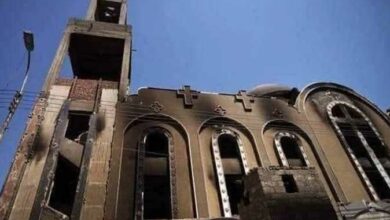As President Barrack Obama hailed the “Arab Spring” from Washington, Egyptian security forces moved to take control of the poor Cairo suburb of Ain Shams, where a group of Coptic Christians and Muslim extremists clashed earlier in the day. The crises in Ain Shams appeared to have been resolved by evening Thursday, as Muslim protesters beseiging a church agreed to back down and allow the church to reopen in accordance with government decrees.
The clashes in Ain Shams were the latest in a series of sectarian violence to strike Egypt, and the first since a Salafi-lead crowd attempted to burn down the Saint Mena church in Imbaba on 8 May. Egyptian Copts had responded by occupying an area in front of the state television building in Cairo to demand greater rights.
Bowing to the demands of Coptic protesters who have camped out in front of the State Television building in downtown Cairo, Egypt’s military government has pledged to reopen several Coptic churches closed by the Mubarak regime, the first of which was to be the “Church of the Virgin Mary,” housed in a former factory in the neighborhood of Ain Shams. A small detachment of police accompanied a group of Copts was hoping to reopen the church early Thursday.
However, the Copts found themselves greeted by hundreds of Muslim protesters some of whom began throwing stones. Local witnesses claimed that Copts climbed the roof of the church and began throwing objects as well. “People from the mosque gathered and they decided that they couldn’t allow them to build the church without the government permission,” explained Hassan, a resident of Ain Shams. “Then some kids suddenly joined the group and started throwing stones.”
Many of the area’s residents seemed unaware, or in disbelief, that the church was being reopened legally.
Coptic eyewitnesses blamed the brawl on Salafis, an extremist branch of Sunni Islam. Following the violence, traditional sheikhs, or Muslim clerics, attempted to restore calm in the streets of Ain Shams. Late in the evening sheikhs could be seen explaining to groups of young men that a Coptic Church was not a problem. According to Hassan, local sheikhs explained to residents that “the construction of churches doesn’t affect Islam in any way.”
Despite efforts by some religious leaders to contain the violence, Muslim and Copt residents of the area allege that government security forces largely remained passive as the scene grew violent. By night fall, armored cars and a dozen police trucks had been deployed to the area, and the police detained nearly a dozen people, among them Copts and Muslim alike. The streets remained crowded with young male onlookers hours after the clashes had ended.
Egyptian soldiers formed lines to block approaches to the church, while soldiers in full combat gear patrolled the neighborhood’s narrow streets. Copts said they worry that the church will be set on fire if the army withdraws. Elsewhere, locals sat in cafes or shops, seemingly unaffected by the upheaval just a few streets away.
Like Imbaba, the site of sectarian conflict on 8 May that resulted in 15 deaths and hundreds of injuries, Ain Shams is one of Cairo’s poorest neighborhoods. Many cab drivers refuse to go there and the streets are unevenly paved. Exposed plumbing runs up the side of apartment buildings, some of which lack glass windows. Refuse is burned in heaps several feet high.
Although Ain Shams is overwhelmingly Muslim, it is home to substantial Coptic minority which has one church in the neighborhood. Magdy, a Coptic resident who fled the neighborhood during the clashes, explained that his community wanted to build a second church. He said that Muslim and Christians in the area “have never had any sectarian issues before.”
News of the clash at Ain Shams was met with renewed calls from Copts to continue their protests at the State Television and Radio building. However, the Coptic protesters Thursday evening announced the suspension of protests until the following morning in order to confirm the church's reopening.




